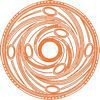Winner’s history
Winner’s history must be rewritten italian text
The heart, the soul of a civilization, undoubtedly speaks through its artefacts, objects and products, but it is the meaning of its works, its ideas and intuitions that express its authentic identity.
Distorting the value of the ideas of a population by deforming the sense of its culture and spirituality means striking at its true essence and at the core of its nature.
History teaches that it is all too possible to mispresent the significance of certain events, to exploit history purposely as a means of portraying, for example, the enemy as unworthy people that deserve to be eliminated or punished.
History has really been written by the winners. The losers, many, have not had a voice to tell their story, and it is inevitable that the current historical knowledge is often deeply falsified, having been manipulated and filtered by partial authors or, even worse, distorted by dogmatism and beliefs that do not allow discussion or self-criticism.
Manipulation and falsification of historical facts is much more common that what is believed. It is the favourite weapon for those who wallow in power games, set up to maintain power and authority above their own kind.
A great writer and divulger, Werner Keller, in his preface of “Etruscan civilization” said, “there has not been a population and culture that has been so mistreated and misunderstood as the Etruscan”. Keller talks of a real operation to discredit, trivialize and falsify Etruscan history and, today, we can see that what stated by Keller still continues; some do so unconsciously, because of their incapability to evaluate what they have been taught; others intentionally, to maintain the status quo and purely for personal purposes that have nothing to do with History and the search of historical truth.
It is well known that the devaluation of the Etruscan civilization, and its role as founder of civilization in ancient Italy, began with the banishing of the Etruscans from Rome. In the centuries that followed, first with the Republic and then with the Sacred Empire, the Romans built the “eternal city” thanks to the techniques, the knowledge and the arts of the Tirrenian;, but officially, everything that was “Etruscan” was not “Roman” and needed to be blocked out, scaled down, to boost the “Romanity”, invoking if anything the distant and mythicized Trojan ancestry, but never the Etruscan past. It is since then that the damnatio memoriae of the Etruscan historical cycle and its meaning begins, a destiny that is not shared in the history of ancient Greeks, or the Egypt of the Pharaohs or the Celts, which instead managed to integrate with the Christian religion, preserving part of their traditions and ferrying them in modern times.
The destiny of the Etruscan civilization, mother-civilization of ancient Italy, is not yet accomplished, its history must still be told.
The damnatio memoriae and the inquisition persecutions went on throughout all Christian Middle Ages, simply because the Etruscan-Roman religion was the “rival” one and the “old religion” was equated to witchcraft. Actually, it was an ancestral cult solidly rooted in the countryside and in the provinces of the whole peninsula; parts of that cult, in a popular version, were preserved until the beginning of the twentieth century, as documented by Charles G. Leyland.
After two millennia of devaluation, archaeologists and historians now present the Etruscan civilization as a minor civilization, a decadent appendix of the Greek world. The image portrayed is of a population of obese and depraved merchants, part of an archaic world in extinction, superstitious ad obsessed by death and by the demons of their sinister religion.
The aim of all these misconceptions is to avoid talking about who, firstly in Italy, brought writing, squared stone, instrumental music, improved metallurgy, painting, land engineering, hydraulics, road networks, practically everything that a “civilization” accomplishes.
In summary two visions emerge today, clashing against each other: one is committed to boost the “Romanity”, imperialist and warlike, by putting the Etruscans in the attic, and the other is the one that is trying to understand causes and factors that brought to the birth of the Roman civilization. Obviously, the answers to all that is in the study of the Etruscans that set the foundations of the future Rome. However, if you distort and falsify culture, religion and history of the Etruscans, as has been done, even the origins of Rome and Christianity become incoherent and falsified.
Instead, the three historical phases are tightly interconnected and have interacted one with the other in ways that until today have been impossible to examine in depth. The heart, the essence of the Etruscan civilization, was a physical location, called “Temple of Voltumna”. There, every year, the twelve populations met and celebrated their religious (not political) unity, with rituals and ceremonies for their communal gods. Lucumoni, auguri, aruspici, fulguratori, sibyls, priestesses, musicians and the delegates of the Etruscan people addressed the divine couple, Veltha and Voltumna. Their religiosity, far from being dark, fatalist and superstitious, flowed into the Roman Religion, under the government of the Etruscan kings of Rome. It was religion of prehistoric origin that exalted life and the mystery of death, interested in natural and supernatural phenomena.
The vision of life and the cosmos, handed down by the lucumonic caste, was transcribed in sacred books; together with Orphism and the Pythagorean teachings, these were the forming elements of the Etruscan, inherited by the Roman and the Christian civilizations. Connections that few historians have taken up.
